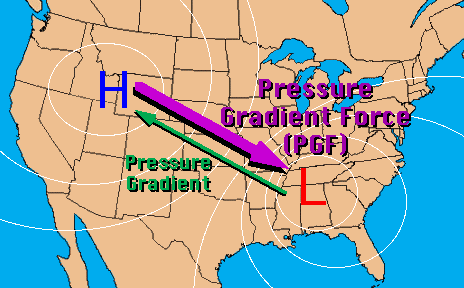Part 1:
Horizontal Motion
Atmospheric motion is influenced by several forces. For explanation and simplicity, we split those forces into those which affect horizontal flow and those which affect vertical motion. The primary forces which affect horizontal motion are the pressure gradient force, the Coriolis force, and friction.
Pressure Gradient
Before we can explain a force, we must understand what causes it. So first, we will explain the pressure gradient. In the atmosphere, there is not uniform pressure everywhere. The increase in pressure over a distance is the pressure gradient. The pressure gradient is a vector, i.e. it has a magnitude and a direction. The magnitude is based on the distance between the high and low pressure centers, and how strong the high and low pressure centers are. The direction is simple -- it points from lower pressure toward higher pressure, as shown below.
Pressure Gradient Force (PGF)
Associated with the pressure gradient is a force. It is called the Pressure Gradient Force, or PGF. Its magnitude is directly proportional to the magnitude of the pressure gradient, but its direction is the opposite. Remember the energy transfer method of conduction? Well, the PGF is similar in behavior. In conduction, heat moves from an area of higher temeprature to the area of lower temperature. In the atmosphere, pressure behaves similarly. Pressure is directed from areas of higher pressure toward areas of lower pressure. The pressure here is a measure of air pressure, so the PGF drives air outward from high pressure regions to low pressure regions.
 Notice that the PGF is directed at right angles to the isobars (in white). If the isobars, or lines of constant pressure, were closer together, then the PGF would be greater, and the wind would blow harder. The PGF is determined by the change in pressure (
Notice that the PGF is directed at right angles to the isobars (in white). If the isobars, or lines of constant pressure, were closer together, then the PGF would be greater, and the wind would blow harder. The PGF is determined by the change in pressure ( p) over the change in distance (
p) over the change in distance ( n), multiplied by a scaling factor which is the negative inverse of the density of air (
n), multiplied by a scaling factor which is the negative inverse of the density of air ( ) according to the equation
) according to the equation

If the earth did not rotate, air would flow directly from the high pressure center to the low pressure center. However, in reality, the air spirals out of high pressure areas in a clockwise direction and spirals into low pressure areas in a counter-clockwise direction. This spiraling is due to the Coriolis force, our next topic.






 p) over the change in distance (
p) over the change in distance ( n), multiplied by a scaling factor which is the negative inverse of the density of air (
n), multiplied by a scaling factor which is the negative inverse of the density of air (
 The Shodor
Education Foundation, Inc.
The Shodor
Education Foundation, Inc.